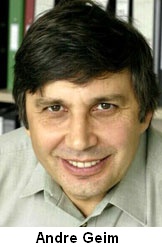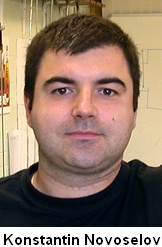2010年度的诺贝尔物理奖(Nobel prize for physics)得主揭晓,两位来自俄罗斯的研究学者Andre Geim与Konstantin Novoselov以“关于二维石墨烯材料的开创性实验”赢得桂冠。
根据诺贝尔奖主办机构的资料,目前在英国曼彻斯特大学(University of Manchester)担任教授的Geim与Novoselov,是在2004年就用普通的胶带从一片石墨中采取出石墨烯,并因此取得碳材料薄片;但在当时,这种材料型态被认为是不稳定的,不如将碳片包裹成球状的富勒烯碳60同素异形体(fullerene C60 allotrope)。
但现在,石墨烯已被证实是世界上最薄也最坚固的材料,既强韧又可挠,而且具备良好的导热与导电性。电子在石墨烯中的迁移距离比在任何材料中都远,也为该材料在电子领域开启了广泛的应用,例如可协助通讯科技跨入Terahertz等级频谱的石墨烯晶体管、高性能的石墨烯IC,以及对毒物与污染物具备更高敏感度的传感器,都已经问世。
 |
 |
此外石墨烯也可适用触控屏幕以及光学领域,并能催生更薄、更具灵活度且重量更轻的复合材料。现年36岁的Novoselov是在荷兰攻读博士学位时首度与51岁的Geim合作,并追随Geim前往英国;这两位诺贝尔奖得主的物理学生涯发源地都在俄罗斯,将平分总额约为150万美元的奖金。
点击进入参考原文:Graphene research wins Nobel prize, by Peter Clarke
《电子工程专辑》网站版权所有,谢绝转载
{pagination}
Graphene research wins Nobel prize
by Peter Clarke
Andre Geim and Konstantin Novoselov, two researchers who began their careers in Russia, have been awarded the 2010 Nobel prize for physics "for groundbreaking experiments regarding the two-dimensional material graphene."
Geim and Novoselov, both now professors at the University of Manchester, extracted graphene from a piece of graphite using regular adhesive tape, according to the Nobel organization. They were able to obtain a flake of carbon in the graphene form, which at the time, 2004, was thought to be unstable, unlike the fullerene C60 allotrope where the carbon sheet is wrapped up into ball.
However, graphene is the world’s thinnest material and is also the strongest, while being stiff and yet flexible and extremely good conductor of heat and electricity.
Electrons travel further in graphene than in any other material, opening up a range of electronic applications. These include: graphene transistors that could help communications technologies exploit the terahertz part of the electromagnetic spectrum; high performance graphene-based integrated circuits and toxin and pollution sensors that are more sensitive than those currently available.
Graphene is also suitable for use in touch screens and optical applications and holds out promise for the creation of thin, elastic, lightweight composite materials
Konstantin Novoselov, 36, first worked with Andre Geim, 51, as a PhD-student in the Netherlands. He subsequently followed Geim to the United Kingdom. Both of them originally studied and began their careers as physicists in Russia. The laureates share the SEK 10 million prize (about $1.5 million) equally.
Professor David Delpy, chief executive of the Engineering and Physical Sciences Research Council, said: "This work represents an enormously important scientific development; an exciting new material that has a huge range of applications and will no doubt bring significant benefits to the U.K. economy. EPSRC has been supporting research by Professor Geim and his group for nearly 10 years and our latest grant has enabled the U.K. to retain the key academic and research staff behind this discovery, who might otherwise have been lost to foreign institutions."